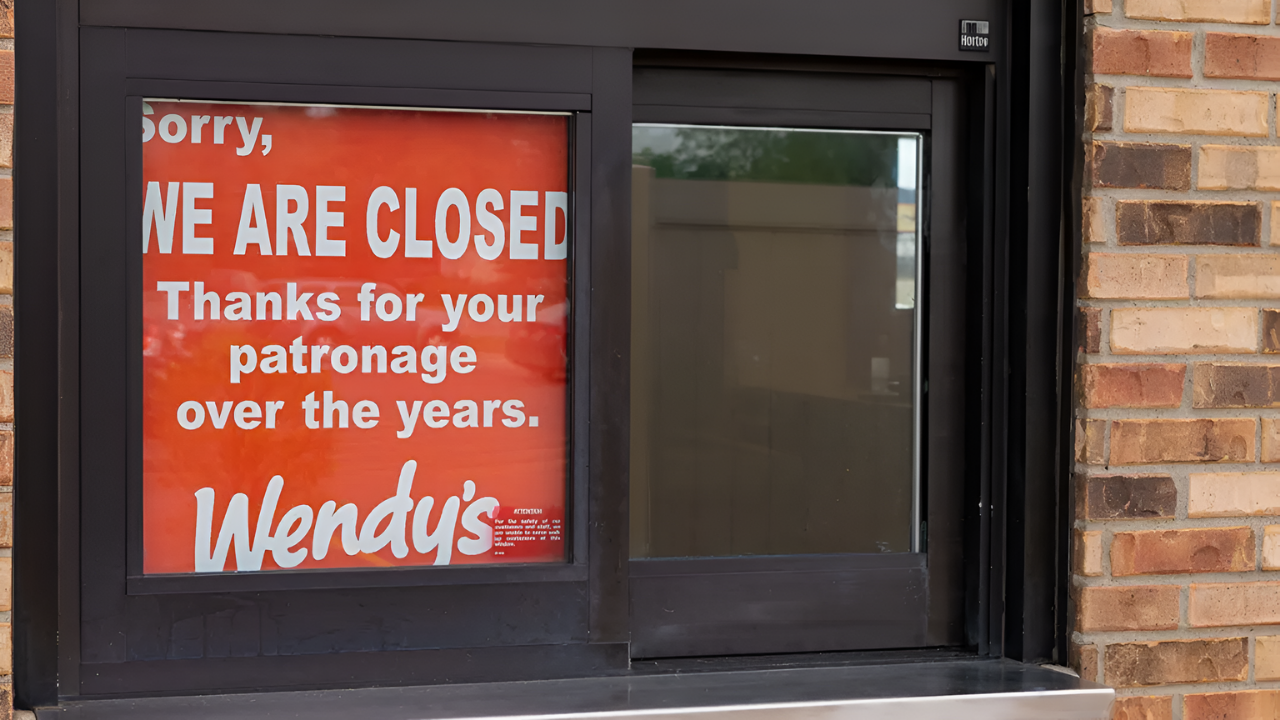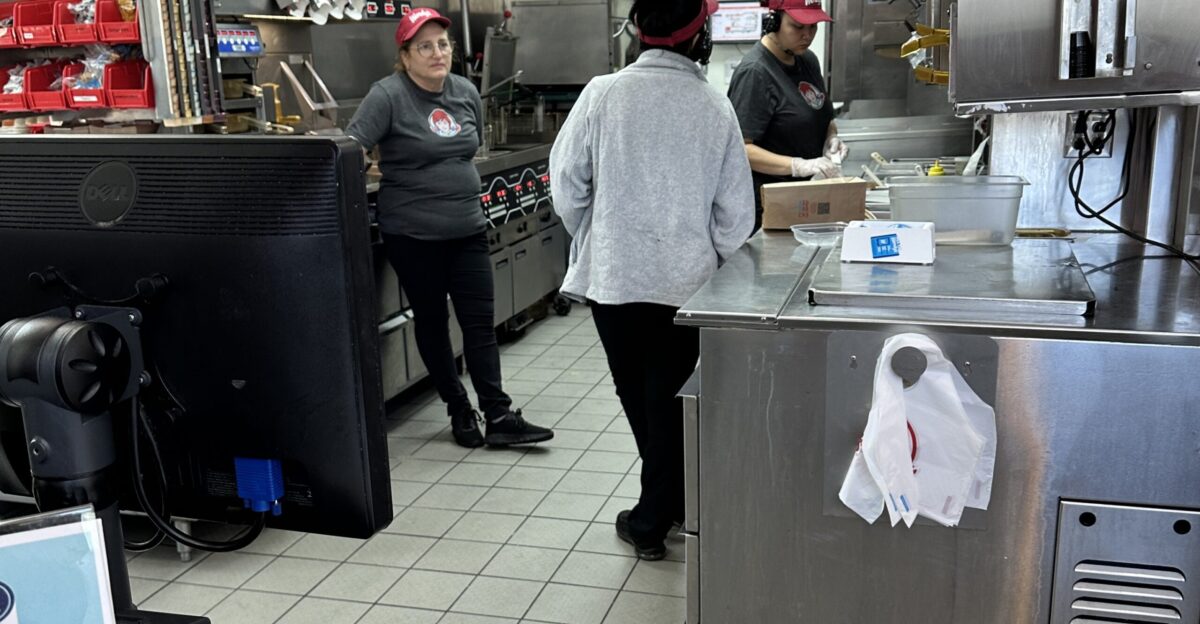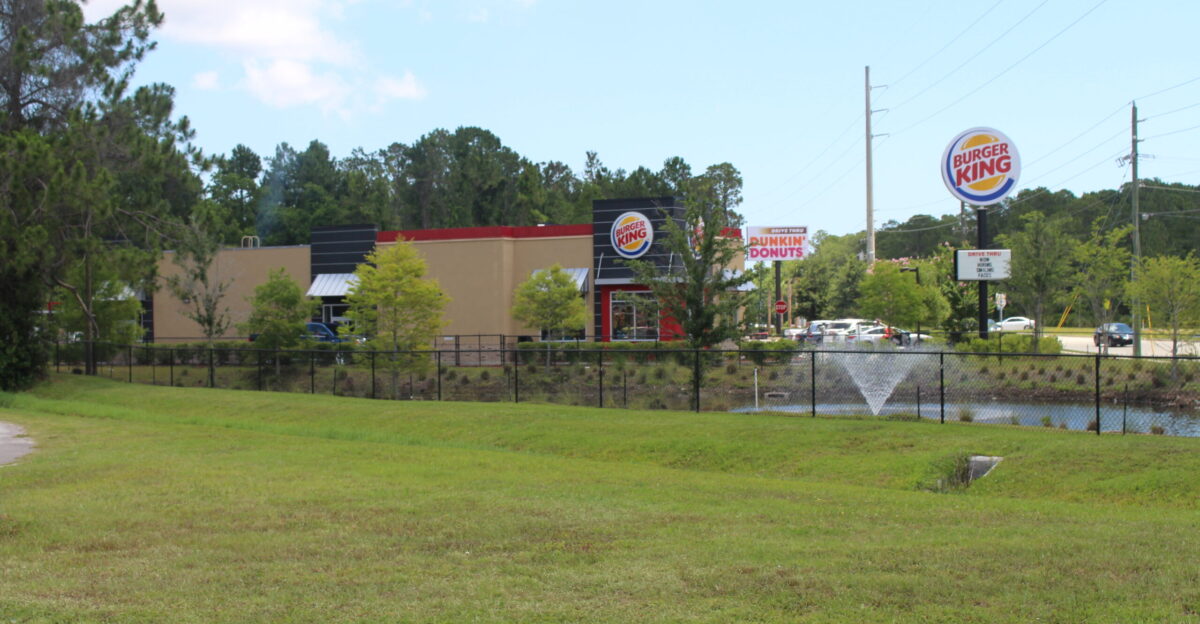
It’s happening now. Wendy’s is quietly preparing to shutter 300 restaurants nationwide, an announcement that sent shockwaves through franchise networks and devastated thousands of workers, who are still unaware that their jobs hang in the balance. Interim CEO Ken Cook called it “a necessary purge,” but for employees, families, and struggling franchisees, this is an earthquake.
The closure wave set to unfold through late 2025 and 2026 represents the burger chain’s most aggressive retrenchment in five years, signaling a company in crisis.
McDonald’s and Burger King Are Thriving?

While competitors feast, Wendy’s bleeds. In Q3 2025, Wendy’s same-store sales crashed 4.7%—a devastating plunge that stands in brutal contrast to McDonald’s 2.4% gain and Burger King’s 3.2% surge. According to the official earnings report via PR Newswire, the company is losing customers to rivals that offer deeper discounts and implement more innovative digital strategies.
The competitive gap has become a chasm, forcing Wendy’s leadership to make an unthinkable choice: eliminate nearly 300 underperforming locations to ensure its survival.
How Wendy’s Went From Growth to Mass Closures

The numbers tell a shocking story. In 2022, Wendy’s closed only 35 locations while opening 101 new restaurants. In 2023, the chain remained positive with 59 closures offset by 102 openings, according to QSR Magazine. But 2024 marked the turning point: 140-240 locations shuttered. Now, 2025’s 300-closure plan represents a stunning reversal from the chain’s five-year trajectory.
This isn’t cyclical; this is systematic collapse. The data proves that Wendy’s franchise model is flawed, and leadership is aware of it.
8,000+ American Workers Could Lose Their Jobs

Based on Wendy’s own ESG metrics reports, the chain employs approximately 225,000 team members across roughly 6,500 franchised locations, equating to an average of 34-35 employees per restaurant.. Apply that to 300 closures, and you’re looking at 10,500-12,000 workers potentially affected—making the 8,000-worker headline a conservative lower bound.
As of November 2025, the company has not released any severance plans, transition assistance, or community impact assessments.
Ken Cook’s Brutal Admission

During the November earnings call, interim CEO Ken Cook didn’t mince words. “When we look at the system today, we have some restaurants that do not elevate the brand and are a drag from a franchisee financial performance perspective,” he told investors, according to CNN. “The goal is to address and fix those restaurants.”
Translation: Wendy’s is cutting loose 300 franchises it views as liabilities. But for operators who’ve invested decades building those locations, Cook’s clinical language masks devastating financial losses and crushed dreams.
The Crisis Wendy’s Can’t Ignore Anymore

“We do see more pressure on the lower-income consumer,” Ken Cook admitted during the earnings call, as reported by CBS News. “We continued to see that in Q3, and we expect that to continue into the fourth.” This confession is damning.
Wendy’s built its empire on value pricing for working Americans—but those exact customers are now abandoning the chain for competitors offering better deals or digital convenience.
Franchisees About to Face Financial Ruin

Franchise operators control the vast majority of Wendy’s U.S. locations, and they’re in panic mode. Closure expenses include lease buyouts, severance obligations, and lost future earnings—costs that primarily fall on owners, rather than corporate headquarters.
According to CBS News, Wendy’s says it will “work with” some franchisees, but the reality is brutal: many operators will absorb catastrophic financial losses from locations they’ve poured fortunes into. .
Where Will the Closures Happen?

It’s November 2025, and Wendy’s has kept the closure list secret. Local managers, employees, and city officials are still guessing which restaurants will survive. According to Nation’s Restaurant News, Ken Cook told analysts that the company’s assessment will continue “over the next several months,” with closures beginning in late 2025.
This prolonged uncertainty is cruel. Employees can’t plan futures. Franchisees can’t decide whether to fight or flee. Communities can’t prepare for employment shocks. The suspense is a form of corporate torture.
Can Wendy’s Turnaround Consulting Save the Chain?

Enter Greg Creed—the executive who engineered Taco Bell’s resurrection when it seemed hopeless. Creed UnCo, his consulting firm, now guides Wendy’s “Project Fresh,” a four-pillar transformation: brand revamp, operational excellence, system optimization, and strategic capital reallocation, according to QSR Magazine.
The hope? Digital innovation, menu modernization, and improvements to franchisee profitability could help stabilize the remaining locations. But consulting alone rarely saves drowning chains. Can Creed work miracles at Wendy’s, or is Project Fresh just lipstick on a decaying pig?
Greg Creed’s $20 Million Gamble

Wendy’s is cutting $20 million from its “Build to Suit” property development program, redirecting capital toward digital technology and mobile apps instead, according to QSR Magazine and Restaurant Dive. This strategy signals a seismic shift: stop opening new locations and maximize profit from survivors through tech innovation. The bet is existential.
Digital menu boards, app-based deals, and hospitality training at pilot company-operated stores have “significantly outperformed” franchisee locations, Cook acknowledged. If these pilot successes scale nationally, remaining restaurants might stabilize. If they don’t, Wendy’s faces a slow death.
Chicken “Tendys” to Save Wendy’s

In September 2025, Wendy’s launched “Tendys”—chicken tenders designed to compete in the fast-food chicken wars. Some locations sold out before the national campaign even aired, according to CNN and USA Today. Cook hailed it as an “encouraging first step to reestablish our leadership position in chicken.” But here’s the brutal reality: one successful menu item cannot arrest a 4.7% same-store sales collapse.
Tendys is a bright spot in a darkening picture. Menu innovation matters, but it’s not enough when structural problems such as competitive disadvantage, consumer abandonment, and franchise dysfunction are tearing the system apart.
Why Wendy’s Pricing Strategy Completely Failed

Wendy’s rolled out $5 and $8 value meals to compete with McDonald’s and Burger King, matching competitors dollar-for-dollar. It didn’t work. According to ABC News coverage of Cook’s earnings statements, the company’s own analysis revealed “price isn’t everything.” Customers didn’t just want deals; they wanted McDonald’s or Burger King. Wendy’s value messaging failed to resonate.
The company learned too late that loyalty, brand perception, and digital engagement outweigh price in the fast food industry.
McDonald’s Captured the Low-Income Diner

McDonald’s U.S. same-store sales climbed 2.4% in Q3 2025, beating Wendy’s by a staggering 6.7 percentage points. According to Bloomberg and Nation’s Restaurant News, McDonald’s “value meal strategy captured both cost-conscious and higher-income diners.” Wendy’s, once the value leader, lost its identity and customer base to a rival it once dominated.
Working-class Americans—Wendy’s historical base—have concluded McDonald’s offers better value, better execution, and better digital integration. That verdict may be impossible to reverse.
Wendy’s Wake-Up Call

Just two years ago, Burger King faced its own reckoning, with 300-400 closures projected for 2023, according to Eat This, Not That and Restaurant Dive. It was a cautionary tale Wendy’s should have heeded. Instead, leadership doubled down on legacy strategies, while competitors innovated more quickly.
Now Wendy’s is executing its own massive retrenchment—proving that franchisees can’t save chains that corporate ignores. Burger King’s crisis should have prompted an immediate strategic overhaul at Wendy’s. It didn’t.
How 300 Closures Destroy Communities

Wendy’s closures aren’t isolated economic events—they’re community-level earthquakes. Local food vendors, cleaning services, supply chain partners, and landlords lose major contracts. In single-store counties, the closure of a single Wendy’s can devastate the local commercial ecosystem.
Some towns will lose their largest entry-level employer overnight. Schools lose cafeteria funding. Local nonprofits lose charitable giving. The collateral damage extends far beyond Wendy’s balance sheet.
International Wendy’s Are Thriving While U.S. Burns

There’s a stunning disconnect in Wendy’s global portfolio. While U.S. same-store sales crashed 4.7%, international operations surged 8.6% in Q3 2025, according to the company’s official earnings via PR Newswire. The chain added 54 net restaurants globally, with “clear momentum in Asia and Europe,” executives confirmed.
This disparity reveals an uncomfortable truth: Wendy’s model is effective elsewhere but fundamentally flawed in America.
The Stock Market Has Already Written Wendy’s Obituary

When Wendy’s announced the 300-closure plan on November 6, 2025, the stock market responded with brutal precision. Shares plummeted 7% on announcement day, then dropped an additional 5-6% in subsequent trading, according to ABC News. Wall Street is signaling its verdict: Wendy’s recovery is uncertain.
Investors aren’t confident that Project Fresh will be successful, and they’re not convinced that the remaining locations will prove profitable.
When Will Your Local Wendy’s Close?

Wendy’s plans to complete restaurant portfolio reviews by mid-2026, with closures ramping through summer 2026, according to CNN. Some locations will close in late 2025; others will remain open into 2026. This phased timeline maximizes uncertainty and extends the suffering.
For 8,000 workers and their families, the countdown has begun—but nobody knows their personal deadline.
Largest Closure Wave Since the COVID-19 Pandemic

Context makes this crisis even clearer: 2022 saw just 35 Wendy’s closures (resulting in net positive growth); 2023 had 59 closures (still resulting in net positive growth). Only 2024’s 140-240 closures hinted at trouble ahead. Now, 2025’s 300-closure plan breaks all recent records. Combined with 2024’s wave, Wendy’s is executing a two-year contraction that exceeds any recent retrenchment by any burger chain.
This isn’t a typical business cycle; it’s a systematic unwinding. Leadership’s inaction from 2020 to 2023 contributed to the creation of this crisis. Now, workers and franchisees pay the price.
Is This the Beginning of the End?

As Project Fresh accelerates and 2026 approaches, one question haunts every stakeholder: Can Wendy’s recover, or are these closures just the opening chapter of a more prolonged decline? Interim CEO Ken Cook insists the restructuring will “strengthen the system and enable franchisees to invest more capital,” according to CNN. But the market is skeptical.
The coming months will determine if this is a painful but successful turnaround or the starting point of Wendy’s slow-motion collapse. The stakes couldn’t be higher for nearly 8,000 workers, who are hanging in the balance.


